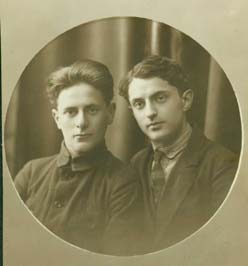 |
Leib Glantz was born in 1898 in Kiev, the Ukraine. His father and both grandfathers were great cantors with Chassidic backgrounds.
Leibele, as he was fondly nicknamed, was eight years old when he first appeared as a cantor. Word spread swiftly about the child prodigy, and invitations to appear flowed in from all over Europe.
In his teens he organized and conducted a large choir in his father’s synagogue, a choir that would sing highly complex choral compositions by Baruch Schor, Solomon Sultzer, Louis Lewandowsky, Avraham Berkovitz Kalechnik, Joseph Goldstein, Nissan Belzer, David Novakowsky and Eliezer Mordechai Gerovitsch.
 |
He studied piano at the music school of the great Ukrainian pianist and composer, Nikolai Tutkovski, and composition at the Kiev Music Conservatory under the famous composer Reinhold Gliere.
In those years Glantz traveled numerous times as a delegate to congresses of the He’Chalutz movement and to World Zionist Congresses. He also assumed the position of chief editor of the Labor Zionist newspaper Ard Un Arbeit.
 |
However in July 1926, due to his intensive Zionist activism, and the growing antagonism towards the Jews from the Romanian regime in Besarabia, Glantz decided to leave Eastern Europe. His plan was to immigrate to Palestine, which was then governed by the British, in order to join those of his Zionist friends who had already immigrated to Israel. However, he first traveled to the United States to record his early compositions. When he appeared in New York, he made a great impression and was offered a prestigious position as chief cantor of the famous Ohev Shalom synagogue in New York.
 |
In America Glantz continued to develop his musical education, under the guidance of the famous professor Aspinol, the vocal teacher of the greatest opera singers of all times, Enrico Caruso and Benjamino Gigli.
In 1929, as a recording artist with RCA, a series of LP recordings included Shema Yisrael, Tefilat Tal, Shomer Yisrael, Kol Adoshem, Lechu Neranena, Birkat Kohanim, Ki Ke’Shimcha, Ki Hineh Ka’Chomer and Ein Ke’Erkecha.
Glantz’s made concert tours all over the United States, Canada, Mexico, South America, Western and Eastern Europe, South Africa, and Palestine.
In 1936 Glantz married Miriam Lipton, and they had two sons, Kalman and Ezra.
 |
In 1942, the family moved to Los Angeles, California, where Glantz served for five years as Chief Cantor of Sinai Temple, and from 1949 to 1954 at the Sha’arei Te’filah synagogue.
In 1948 he lectured before the delegates of the First Annual Conference of the Cantors Assembly of America on the subject: How the different Jewish Nuschaot (Prayer modes) were created.
 |
He articulated his musical theories in a famous lecture to the delegates of the 5th Convention of the Cantors Assembly in 1952, a lecture that created a serious debate, as his ideas were considered a new path toward the analysis of the ancient Jewish prayer modes, the Nusach.
Glantz theorized that many centuries ago the Jewish people transformed the Greek Pentatonic scale and the Greek Tetrachords and modes, in the process creating original combinations. These became the foundations for the Cantillation of the Torah (Ta’amei Ha’Mikrah) and the Jewish prayer modes (Nusach Ha’Tefila.).
Glantz continued to be active in the Zionist movement as one of its outstanding leaders. He was nominated to be a delegate to no less than eleven World Zionist Congresses from 1921 till 1961.
 |
Glantz lived in Israel for the last ten years of his life (1954-64). In Israel he enjoyed intimate interaction with a congregation that understood the language of the prayers, was able to appreciate his unique interpretations of the texts, his adherence to the ancient prayer modes and his authentic musical innovations. He was immensely popular in Israel – a household name. Many of his greatest compositions were composed in this period of his life.
Midnight Selichot Service, composed by Leib Glantz, is considered by many cantors and scholars as the greatest cantorial work ever published. It was recorded live by Kol Yisrael radio from the Tiferet Zvi synagogue. In total, Leib Glantz composed 215 compositions of Cantorial, Chassidic and Israeli music.
 |
In addition to his cantorial career, Glantz appeared in leading tenor roles in operas, including Alan Hovhaness’ “Shepherd of Israel”, Jacques Halevy’s “La Juive”, and Joseph Tal’s “Saul at Ein Dor”.
In 1959 Glantz founded the Tel Aviv Institute for Jewish Liturgical Music, and an academic level conservatory for training cantors -- the Cantors Academy (Ha’Akademia Le’Chazanut.) With Glantz at the helm, many important scholars and musicians proudly joined the academic faculty.
Following Glantz’s sudden passing on January 27, 1964, while in concert in Tel Aviv, the Tel Aviv Institute for Jewish Liturgical Music was transformed into the publishing organ of Leib Glantz’s musical compositions, as well as his research and literary work. This body has published seven books of Glantz’s musical compositions and the Hebrew book Zeharim – In Memory of Leib Glantz.
Books about Leib Glantz:
- Zeharim – In Memory of Leib Glantz (Hebrew, 1965).
- Rinat HaKodesh Series – seven volumes of Leib Glantz’s compositions (Hebrew/English, 1965-1973).
- The Man Who Spoke To God – (English, 2008).
- The Leib Glantz Project – 43 new arrangements of Leib Glantz compositions – (English, 2013).
